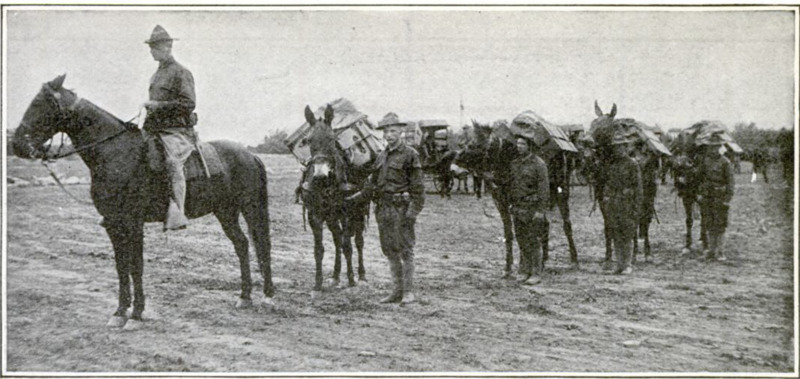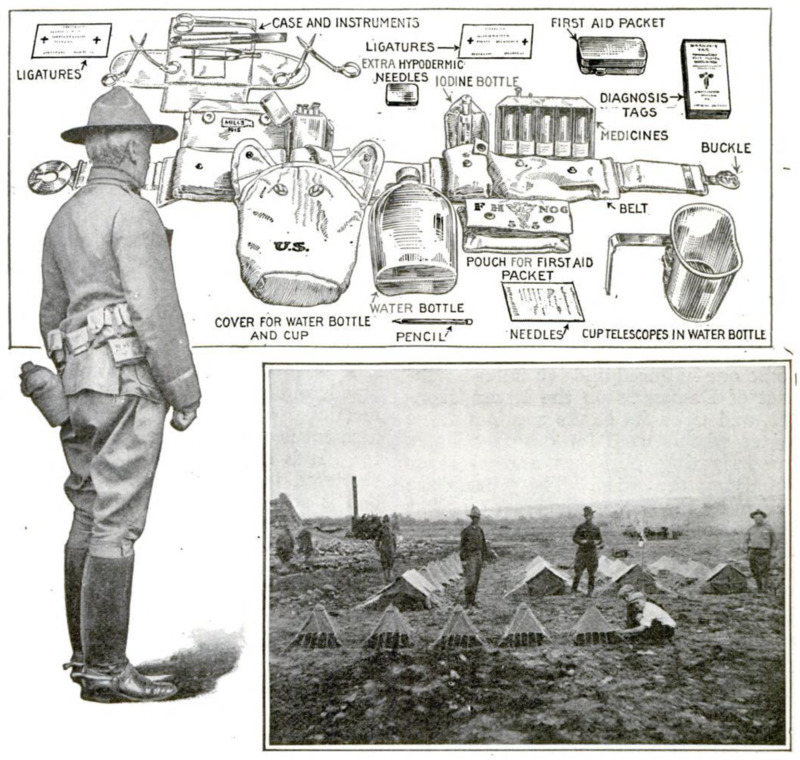-
Titolo
-
Hospital Work on the Firing Line
-
Article Title and/or Image Caption
-
Hospital Work on the Firing Line
-
Caption: The hospital corps of the United States army is learning much from the developments of the war in Europe. It is likely that the old ambulance mule, among other things, will at last give way to the swift light automobile
-
extracted text
-
UNITED STATES field hospitals,
the least understood divisional
units in the United States army,
have been newly equipped in order that
they may be more mobile during battle.
The field hospital service of our army,
as it is constituted today, is one of the
best in the world.
Contrary to popular opinion, field hos-
pital men are trained soldiers. They do
their most important work under fire,
and in war, their dead and wounded rank
next to infantry in number. While
the officers of field hospitals are surgeons
and while the privates have been in-
structed thoroughly in first aid work,
the real duty of the field hospital men
during battle is to keep the front clear
of savable wounded men. The field hos-
pital problem is one of rapid transporta-
tion. During the past four years, since
the system conceived by Tripler during
the Civil War has been put into opera-
tion, every scheme to make it possible
for field hospital officers and men to
work swiftly has been resorted to.
Officers and men of the hospitals
are walking dispensaries. The officers
carry surgical instruments, extra hypo-
dermic needles, needles, ligatures, medi-
cines, first aid packets, large iodine bot-
tles, large water bottles and cups, diag-
nosis tags. During battle the officers can
spend little or no time in dressing wounds
or in “cooling the fevered brows” of
fallen soldiers. Their time is occupied
in directing the bearer-men, or littermen,
who carry wounded soldiers to the field
hospitals just outside the line of fire.
While doing this transportation work, the
stretcher bearers are really more under
fire than the fighting soldicrs.
The new equipment furnished the
field hospital men is as compact and as
light as possible. Each man carries a
meat can, a bacon bag, knife, fork and
spoon, a water bottle, ten first aid pack-
ets, iodine swabs, five plain gauze ban-
dages, safety pins and adhesive plaster,
corrosive sublimate gauze, diagnosis
tags and pencil, a large water bot-
tle, instrument cases, forceps, scissors,
and a hatchet. The enlisted men are
thoroughly trained in the uses of the in-
struments they carry. When they have
time, they administer first aid treatment
to wounded men, but if they are pressed
for time in the heat of battle, they devote
all their energy to getting savable wound-
ed men to a point where they may be in
comparative safety while awaiting sur-
gical treatment.
The men are taught that their work is
to protect Uncle Sam's fighting mate-
rial. They are not permitted to spend
any time at the front with fatally wound-
ed men, but to strain every nerve in
saving wounded men who can be patched
up to fight again. No nurses are per-
mitted at the front. They are at the
base hospitals, usually out of range
of the enemy's guns. It is possible to
take down and pack up on mule-drawn
ambulances the entire camp equipment
of a field hospital in two hours.
Ordinarily, that 1s, in time of peace,
the camp tentage of a field hospital is
as follows: five small pyramidal tents
for officers, nine large pyramidal tents for
soldiers, five tropical hospital tents for
kitchen, stores, mess, dispensary and op-
erating room, six ward tents each con-
containing thirty-six beds, and tents for
officers’, patients’, and men’s latrines,
with one for the men’s bath. In field serv-
ice the large pyramidal tents are not car-
ried, and one thousand four hundred and
ninety-eight pounds of weight are saved.
No tent furniture or cots are carried.
The field hospital equipment for serv-
ice weighs eight tons and is transported
on eight four-mule wagons, which are
used for ambulances. The army is now
experimenting with motor cars to sup-
plant the mule-drawn ambulances, since
a similar equipment serving with the
American Ambulance on the French
front has proved remarkably successful.
Fifteen horses—seven for the officers,
two for the major, and eight for enlisted
men—go with the field hospital equip-
ment. The organization carries three
days’ rations, three pounds to a man, or
eight hundred and ten pounds, and one
thousand three hundred and sixty-eight
pounds of forage for the animals.
-
Lingua
-
eng
-
Data di rilascio
-
1916-01
-
pagine
-
80-81
-
Diritti
-
Public Domain (Google digitized)
-
Archived by
-
Filippo Valle
-
Alberto Bordignon (Supervisor)




